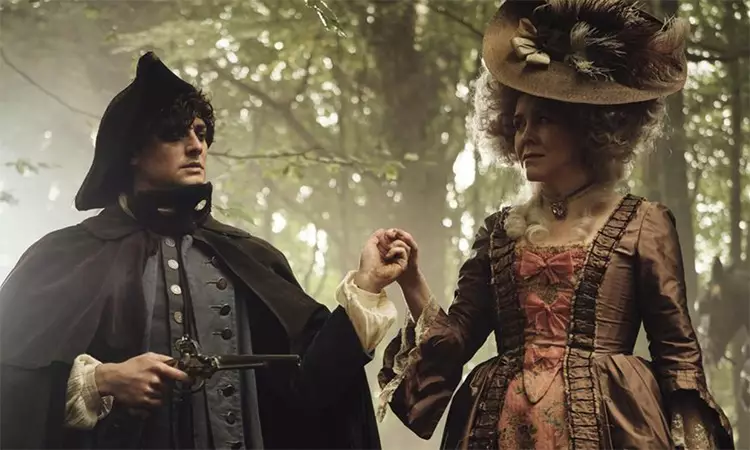In “Timestalker,” writer-director Alice Lowe constructs a labyrinthine narrative that navigates the troubled waters of desire, obsession, and the inexorable march of time. The story of Agnes, played by Lowe herself, introduces viewers to a cycle of reincarnation that unfolds across different historical epochs, challenging conventional notions of love and romance. Unlike traditional romantic stories, “Timestalker” examines the oft-ignored dark side of passion through varied time periods, effectively portraying it as a force simultaneously seductive and destructive. This exploration resonates deeply with themes of unrequited love, misplaced affections, and the often-turbulent emotional landscape of those trapped in their yearning.
The Multiple Lives and Loves of Agnes
Agnes’s predicament mirrors a tragic cycle; she repeatedly falls for Alex (Aneurin Barnard), a character whose allure seems to eclipse her rational judgment. Despite her fervent infatuation, Agnes’s love for Alex is not only unreturned but also leads her to perilous situations across generations—each time culminating in her own destruction. This relentless pursuit evokes the melancholic charm of Max Ophüls’ “La Ronde,” where romance remains unreciprocated, emphasizing the futility of her endeavors. Alongside characters like her loyal maid/friend Meg (Tanya Reynolds) and the brutish George (Nick Frost), who represent different facets of attraction and societal expectation, Agnes navigates a world where affection is as likely to entrap her as liberate her.
The film creates an illusion of progress through Agnes’s repeated births. However, the audience is left pondering whether these new beginnings are genuinely transformative or merely a manifestation of her same misguided patterns. Each incarnation in distinct eras—from the tumultuous 1688 to the technologically advanced 2117—demonstrates how the narratives of romance and desire are not bound by time. Instead, they are an inherent part of the human experience, evolving yet static in their core negativity.
Significantly, “Timestalker” reframes love as a haunting, almost pathological obsession. The titular concept of “timestalking” emerges as a metaphor for the characters’ haunting experiences within their doomed romances. Agnes’s obsession is underscored by visual motifs, such as the pinkish-red canary, which flits between the ideas of freedom and captivity, perhaps symbolizing both Agnes’s desires and her constraints. The vibrant color schemes employed throughout the film suggest passion but also hint at danger, reflection, and the entrapment that comes with desire, making the audience acutely aware of the emotional stakes involved.
Lowe effectively critiques societal norms surrounding love by showcasing Agnes’s fixation on an array of ‘wrong’ partners, contrasting her desires with Meg’s profound yet overlooked affection. Agnes’s repeated choices reveal a deeper commentary on the societal glorification of passionate but toxic relationships and their portrayal in media. In each reincarnation, Agnes’s experiences become increasingly desperate—a reflection of how romantic fantasies can lead to self-destructive behavior and ultimately death.
Timestalker offers a sophisticated deconstruction of the romantic comedy genre. By putting a spotlight on the grotesque aspects of attraction—such as Agnes’s obsessive behaviors, represented visually through “mood boards” that echo serial killer documentaries—the film forces viewers to confront uncomfortable realities about love. Love in “Timestalker” embodies quite the opposite of what it typically portrays—a paradox of longing that leads to despair and chaos. Each iteration of Agnes and her relationships with Alex, George, and others registers an evolving understanding of love’s darker dimensions yet remains tantalizingly unattainable.
Even as Lowe weaves a complex web of timelines and character dynamics, the film remains accessible and engaging. “Timestalker” accommodates humor alongside poignant reflection, skillfully balancing its dark themes with lighthearted moments, thereby distinguishing it from similarly themed narratives that may dwell solely on bleakness. This dichotomy encourages audiences to recognize their own amatory follies, positioning the film within a broader cultural critique of affection and its manifestations.
Ultimately, “Timestalker” succeeds not just as a romantic narrative but as a multi-layered exploration of love’s cyclical nature, replete with its traps and pitfalls. Through Agnes’s repeated reincarnations, the film explores timeless questions about desire, choice, and self-understanding within the framework of societal norms across different eras. The film serves as a reminder that love, while celebrated as one of life’s greatest joys, can also lead to profound disillusionment if pursued blindly. Timestalker, therefore, presents an incisive commentary on contemporary relationships by packaging it intriguingly within the construct of time, inviting viewers to reflect on both the cyclical patterns of their own lives and the universal truths about love that transcend eras.

